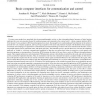Free Online Productivity Tools
i2Speak
i2Symbol
i2OCR
iTex2Img
iWeb2Print
iWeb2Shot
i2Type
iPdf2Split
iPdf2Merge
i2Bopomofo
i2Arabic
i2Style
i2Image
i2PDF
iLatex2Rtf
Sci2ools
CACM
2011
2011
Brain-computer interfaces for communication and control
For many years people have speculated that electroencephalographic activity or other electrophysiological measures of brain function might provide a new non-muscular channel for sending messages and commands to the external world – a brain–computer interface (BCI). Over the past 15 years, productive BCI research programs have arisen. Encouraged by new understanding of brain function, by the advent of powerful low-cost computer equipment, and by growing recognition of the needs and potentials of people with disabilities, these programs concentrate on developing new augmentative communication and control technology for those with severe neuromuscular disorders, such as amyotrophic lateral sclerosis, brainstem stroke, and spinal cord injury. The immediate goal is to provide these users, who may be completely paralyzed, or ‘locked in’, with basic communication capabilities so that they can express their wishes to caregivers or even operate word processing programs or neuroprosthes...
Brain Computer Interface | CACM 2011 | Cortical Potentials | Software Engineering | Word Processing Programs |
Related Content
| Added | 24 Aug 2011 |
| Updated | 24 Aug 2011 |
| Type | Journal |
| Year | 2011 |
| Where | CACM |
| Authors | Dennis J. McFarland, Jonathan R. Wolpaw |
Comments (0)

